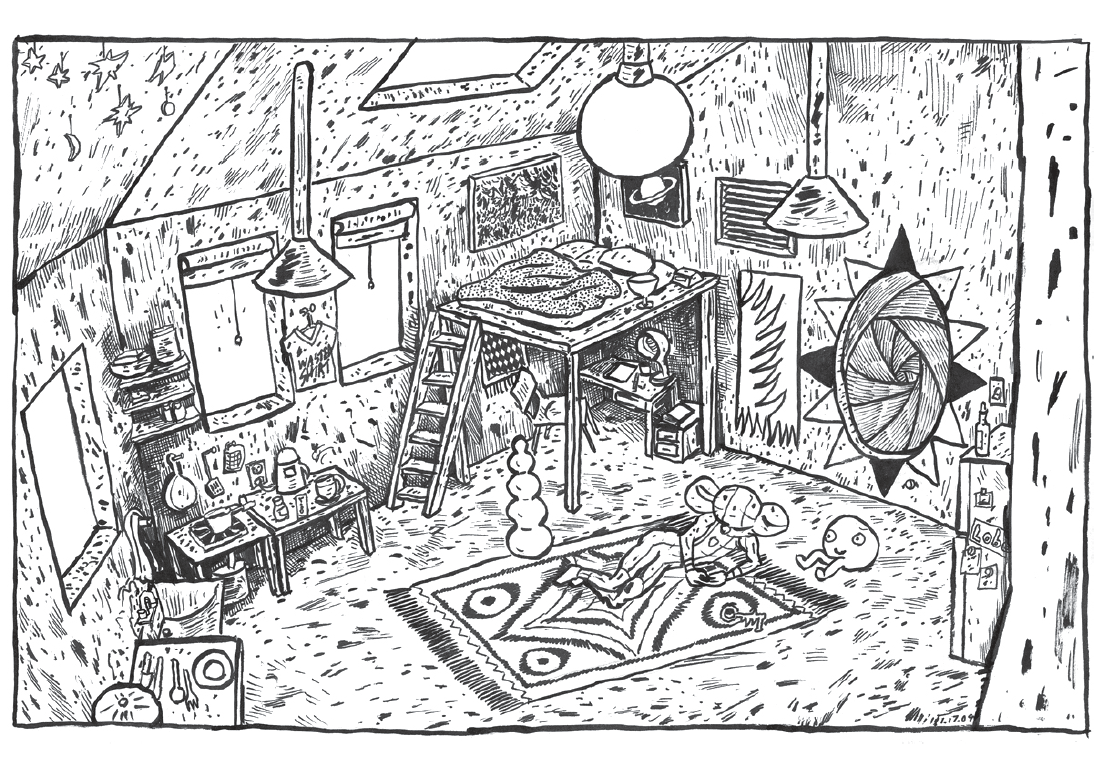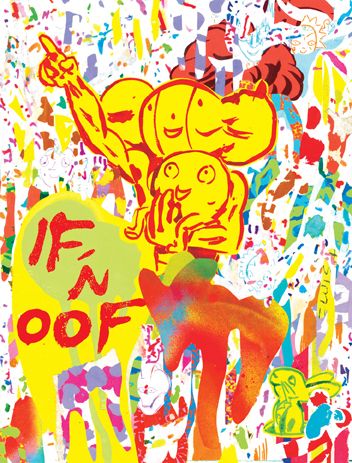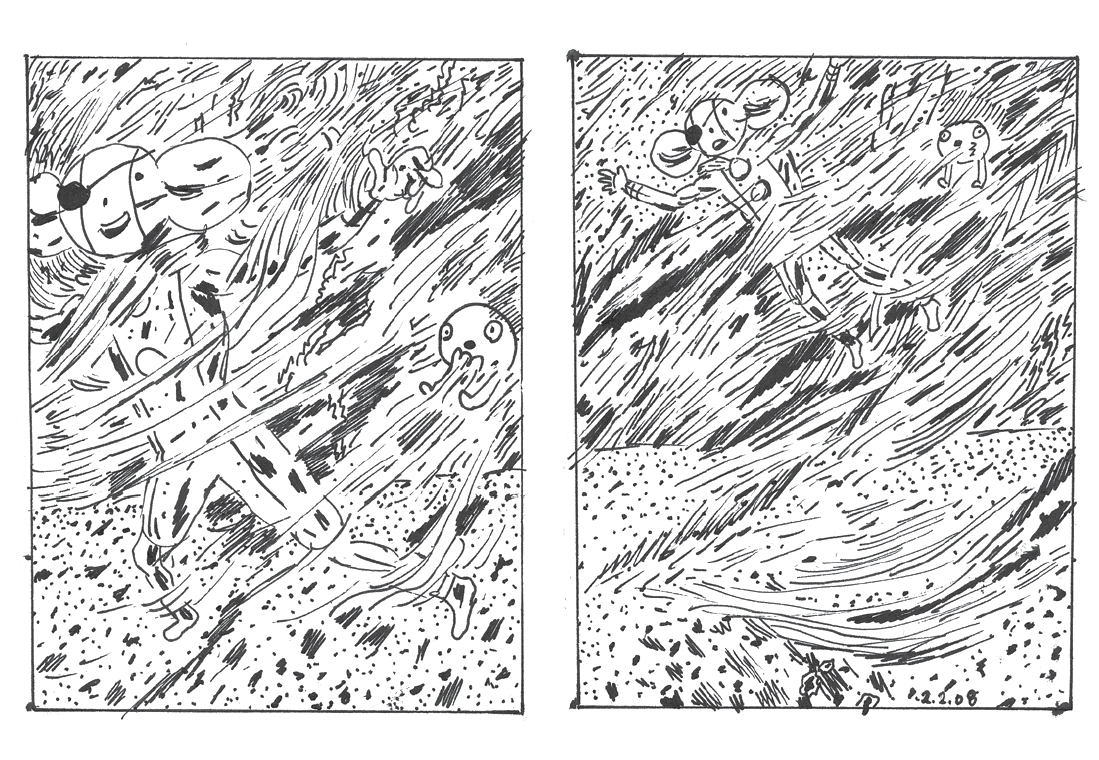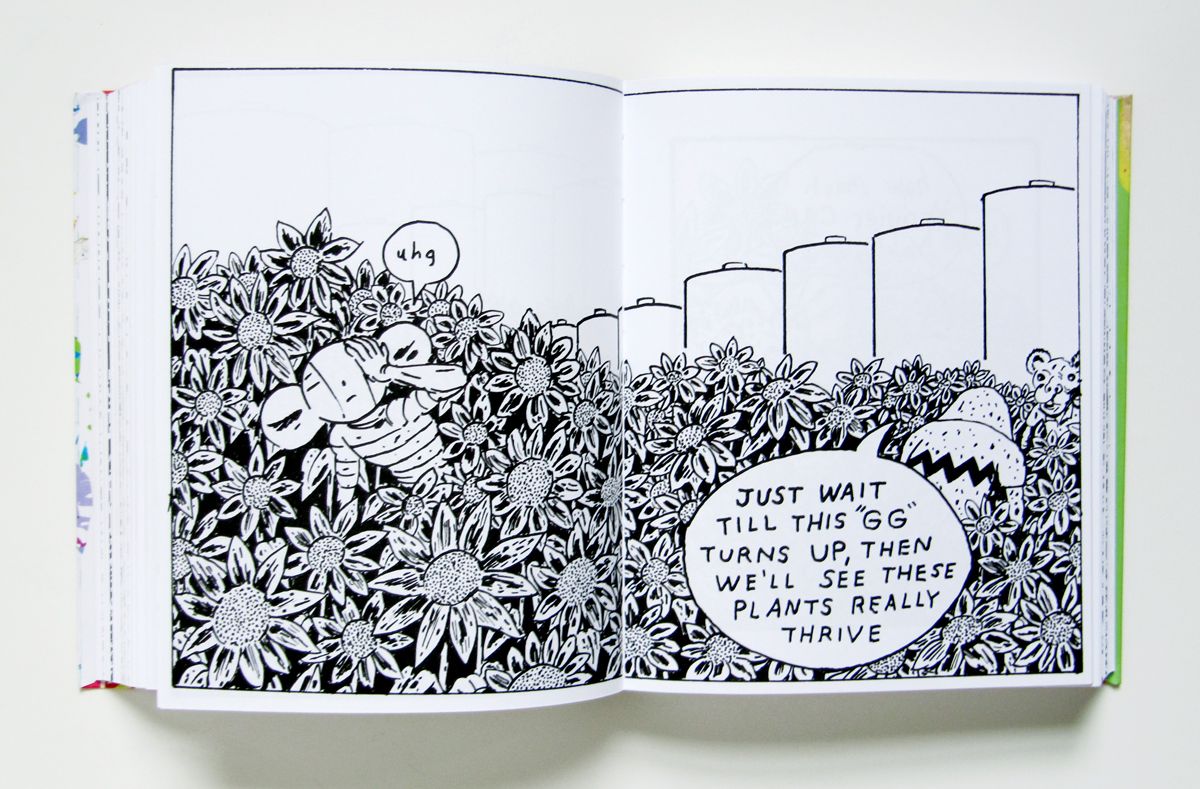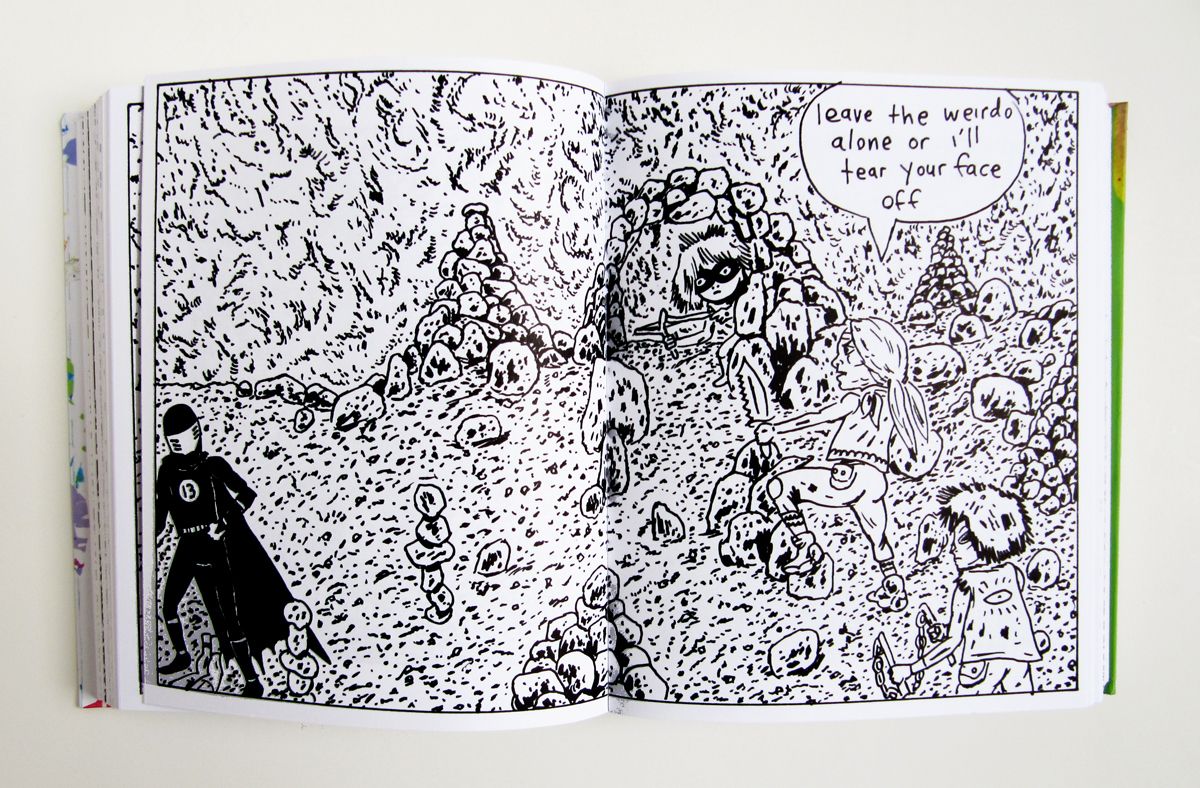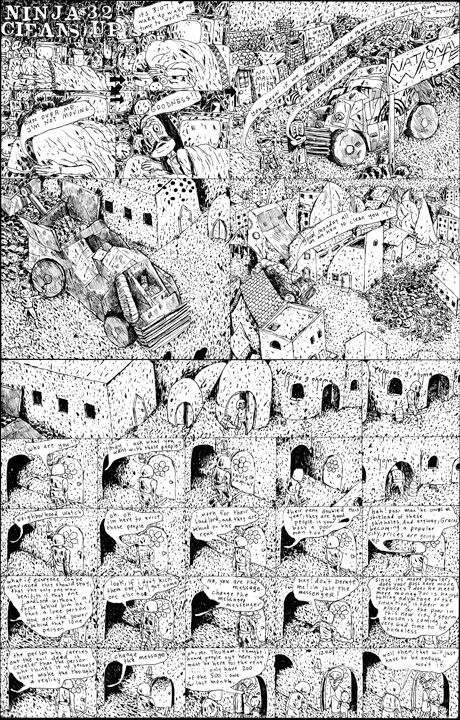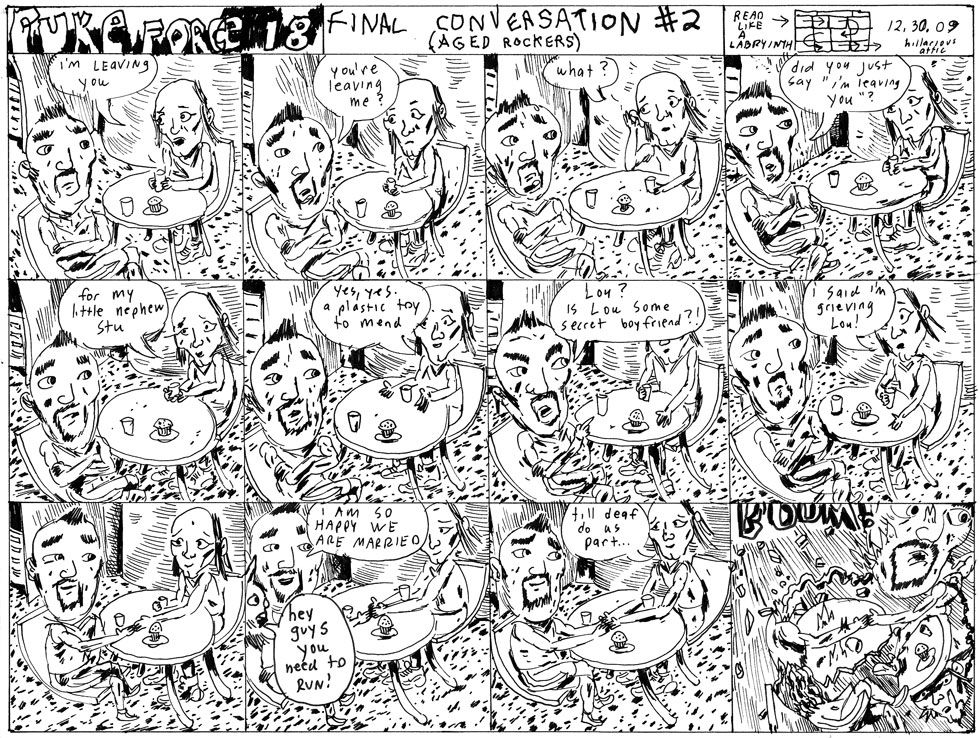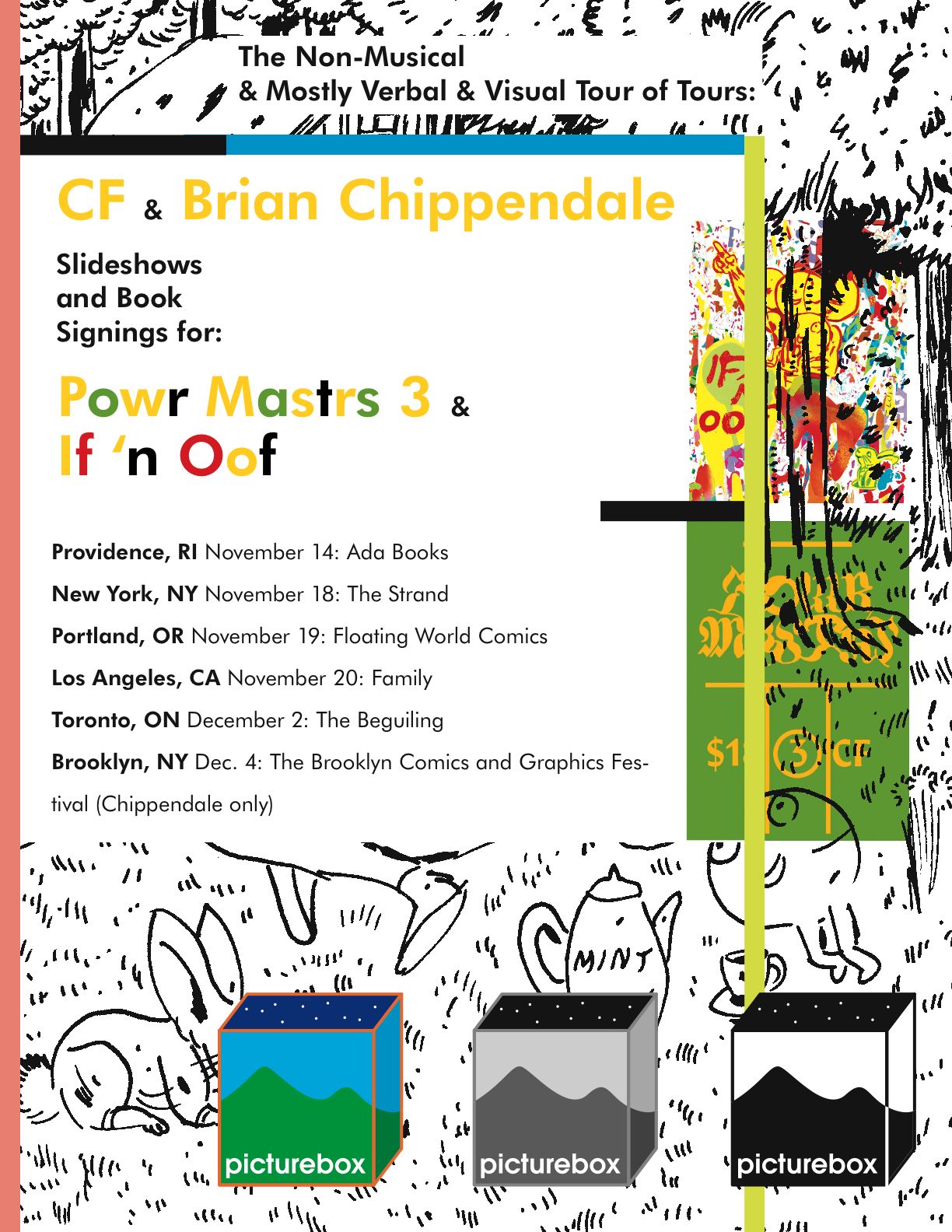Like the characters he chronicles in If 'n Oof, his new book from PictureBox Inc., Brian Chippendale is prone to wandering. He just returned to his home base of Providence last week following a tour with his acclaimed two-man music group Lightning Bolt, whose sound can be best described as "What if Thor's hammer and Loki's helmet formed a band?" He's also gearing up to hit the road again in another couple of weeks for a brief cross-country book tour with fellow PictureBox cartoonist CF.
But it's Chippendale's artistic travels that interest me the most. Each new Chippendale book feels like an experience miles removed from its predecessor. Maggots is a tiny softcover with incredibly dense pages, drawn on top of a Japanese book catalog so that even the white spaces are filled with visual noise. Ninja is a gigantic hardcover with a smoother approach to Chippendale's trademark "snake-style" layout -- you read the first row of panels on a page from left to right, then hop down to the next row and read that one from left to right, then down another level from right to left, and so on back and forth -- and a healthy dose of comics he drew as a kid thrown in. If 'n Oof is a doorstop-sized softcover in manga dimensions in which every page is a splash page or part of a spread. And while all three share Chippendale's unmistakable rough-hewn line and love of sci-fi, fantasy, and action -- an approach forged in the hallowed halls of the late great Fort Thunder collective, alongside artists like Mat Brinkman and Brian Ralph -- If 'n Oof's buddy-movie storyline of two lovable creatures battling their way through a wasteland in search of home (and snacks) is the artist's most accessible work to date. Robot 6 managed to get Chippendale to settle down long enough to talk to us about the new book, how it stacks up against his new webcomic Puke Force, and the tantalizing possibility that as far as If and Oof's world is concerned, we've only seen the tip of the iceberg.
All of your big books have looked and felt so different, on a physical level. When you start a new long project, do you think to yourself, "I want this to be different than what I've done before," or has it just worked out that way?
It's just worked out that way. If 'n Oof, on a simple level, is basically just if you took a single Ninja panel and blew it up to its own page. I was just fucking around in Kinko's with these mini If 'n Oofs, five or six of these tiny comics that were the size of a Ninja panel -- you had 16 panels per 8 ½ by 11 page. I was making these little books in a size and format that I'd lifted off Mat Brinkman; he'd made these little mini books in the '90s. At some point I just blew it up double-sized, messing around in Kinkos, and I was like, "Whoa! These drawings look cool blown up to 200%." The standard panel size in most of If 'n Oof is kind of like a Ninja panel blown up to 200%. Suddenly I was like, "What is this stuff like if you stretch it out, so that instead of having it on one big sheet, you stretch it out longways?"
With any of these things, I don't really set out to do anything. It sorta lands in my lap, and then certain things take hold. If 'n Oof just suddenly ballooned. I started out working on the sixth or seventh chapter of what would be these little mini-books I made. That's why the chapter breaks in If 'n Oof don't say "Chapter 1" or "Chapter 2," they say "If 'n Oof Giant 1" or "If 'n Oof Giant 2." I think that first I made the cover for "If 'n Oof Giant 6" -- 1 through 5 were minis, and I was going to do one special 24-page issue that was double-sized, and that was gonna be issue #6. It was just a thing that got out of control. There was no planning -- it just sorta got bloated.
How much of it was drawn at that tiny size?
It's sort of all over the place. Again, bad planning on my part. The first stuff I drew, I think, was chapters 5 and 6, basically the middle of the book. You can kinda tell -- the drawings get crude in the middle. He meets these boys, they pull a gun him, there's an ice cream cart…those are the first drawings. Then I started working backwards, so the drawings in the beginning of the book are better. They're more refined -- I don't know if they're better. The wrestling match with me was, "I don't know, is refined better, or is crude better?" I ended up keeping everything. The stuff in the middle of the book is drawn small and blown up 200%. Most of it is drawn smaller, actually. Most of the stuff in here is blown up a little bit. Some of the big splashes are shrunk somewhat. There are a few big drawings I shrunk down. A lot of the stuff is maybe blown up 125%. But you can kind of tell, if you look: The stuff in the middle is cruder and scratchier and weirder, and that's the stuff that was drawn smaller.
I never noticed that on an explicit level, maybe because it sort of fits with the story at that point. They're in a wasteland…
Yeah. Well, that's good! I mean, I tried to explain it away with this stupid little thing where If and Oof get hit in the head, and suddenly everything looks shitty after that. He actually says at one point, "Do things look weird to you? We got hit really hard!" [Laughs] I was just trying to make this really arbitrary segueway into the cruder drawing style by them getting hit in the head.
I spotted a lot of flashes of different drawing styles here and there throughout the book, some of which reminded me of different artists. There's a spread of a house that If and Oof are leaving where the blacks remind me of Brian Ralph, and there's a sequence with those weird shaggy barbarian Benjo-Men guys that was sorta like "When Mat Brinkman Comics Attack!"
I thought the Mat Brinkman stuff was the cave scenes -- those were the Brinkman one for me. I didn't picture the Benjo-Men that way, but that's interesting too. That makes sense. I guess he does have some barbarians in his stuff, yeah.
Maybe what reminded me of him there was that one of the Benjo-Men takes a dump on another slain Benjo-Man. I remember that one Brinkman comic from Teratoid Heights where this big brute spends all this time breaking into a castle only to knock the king off his throne and poop on it.
Mat's actually here in my house. He's been here for a couple of weeks visiting and stuff. He pointed out to me that If 'n Oof is like Oaf, his old comic [from Teratoid Heights]. Then he was like, "Oh yeah, Puke Force is like [Brinkman's earlier comic] Multiforce. C'mon, Chippendale, you've been ripping me off left and right!" [Laughs] We're actually supposed to draw a little minicomic together called If Oof 'n Oaf, but we'll see if that happens. He's definitely in there, for sure. There's a little Paper Rad in there, too, I think. In the first chapter there are these robots and clean-lined white hallways. Those simple lines are kind of Paper Rad-y.
The first thing I thought there was Yuichi Yokoyama.
I feel like I've barely looked at Yokoyama, but that would make sense too.
Now that you mention it, there were several points throughout the book where I thought, "Oh, wow, look at that smooth line!" Certain images looked very different from your usual choppy line.
This whole book, for me -- each chapter has its own texture in a way. It was just this weird learning experience. I would attack each chapter as its own thing. I'd finish a chapter, and then a month or two later I'd come back. I'd start drawing the drawings bigger -- most of the time they got bigger as I went. Halfway through I started scripting things out, some of the chapters I was laying stuff out…I wasn't, like, thoroughly in control or something the whole time. It was funny to see how things turned out. It was an experiment, for sure. I'd draw stuff and be like, "Yeah…is this how I draw?" 'Cause I kind of draw a certain way, like Puke Force or Ninja. I mean, Ninja is probably my default drawing now. Trying to draw bigger and communicate in this one page/one panel thing was stretching me. I wasn't necessarily comfortable the whole time. For better or for worse -- I can't even tell.
How did switching away from your snake-style layout to the one-panel-per-page format change the pacing for you? It has to change it almost completely, right?
Well, it does and it doesn't. The thing about the panels…in a weird way, it can almost be viewed as being the same. I'm a drummer, and there's a beat to a lot of the panel things I set up in Ninja. From panel to panel, you're spending the same amount of time on each, you just march through. The reason there's a snake pattern is so there's no gap -- the beat isn't interrupted as you go down the page, in a way. As this book went…I mean, part of the reason it's 800 pages is that I was trying to keep that kind of rhythm, but instead of panel to panel, it's page to page. For the most part, you're supposed to spend the same amount of time on each page. I actually almost think of it as the same thing, in a way. It's still controlling the rhythm.
If anything, I think this gives you even more control. When you have multiple images on a page, no matter what you do with the layout, people are just going to vary how they attack that. But there's almost a limit to what you can do as a reader when it's just one new image with every new page. I mean, obviously you can linger on an image, but there's something about the physical incentive of turning a page to see the next image that keeps it even steadier than the snake layouts.
Yeah, maybe so. I've watched a couple people read it and seen them get into a rhythm. I don't know, I've probably only read it in this form twice now. But there was definitely a conscious effort for rhythm, and it was a similar conscious effort I put into the snake-panel stuff -- like, "This has to feel like it's flowing." That's why it's an 800-page book where there's not necessarily 800 pages worth of stuff in it. Like, they're just walking for a while. I think in a lot of my comics, even way back to Maggots, I've always been interested in getting into this groove. I hope that's recognizable.
The other thing I thought was interesting in terms of the pacing is that there are sequences in which you recreate the way action and comics are staged not even in comics but in film. There's a pivotal sequence near the end of the book that's straight out of Die Hard, and I was struck by how the one-image-per-page layout gave you the ability to nail that dynamic, engaging, suspenseful pacing that good action films use.
[Laughs] That last chapter has been in my head for a year and a half, and I was so terrified about trying to make that work, that whole grand fight scene. There was actually a whole 'nother chapter, a second scenario where they end up running up into a tower and all this stuff, but [laughs] I didn't quite get there. But anyway, that scene was in my head, and I got so nervous about it, but it kind of…somehow…worked! I think penciled it out and read over it…I don't know, it's all new to me, this kind of writing to get a desired effect versus just sorta wingin' it and seeing what happens. Which is generally how Ninja was: I would draw some stuff and sit back and go "How did this turn out? Oh, cool! I wasn't expecting that, but that's what happened." But this time I had this desire, I wanted this suspenseful ending, and it kinda worked. And it kinda worked because of this format, where you can't see what's coming.
That's something Jordan Crane used to talk a lot about when he started making more horror-oriented minicomics. Having one image per page gives you much more control over what people see and when they see it, and enables you to do suspense in a way that comics with several panels per page don't enable you to do, because you can see it coming.
Yeah, they just can't do it. I guess it's the same at Marvel when they have certain splash pages. It's a celebrated technique. When it works, it works. It's pretty fun. This format was fun for me. I really wanna start working on another one. [Laughs] When I laid out this damn If 'n Oof book, I had this one day where I did this ridiculous outline for all these adventures they were gonna have, and I've chipped away at about one sixth of the outline. There's this huge bigger story, and now of course even since when I did that there's all these other little stories I want to do, just stuff that was coming up randomly in the book. I referenced some stuff I want to go deeper into.
It has a sort of Dark Tower feel, where you get these weird little glimpses of things. You don't know the context, but you feel as if they're the fabric of something bigger. That's what I got from If 'n Oof when you'd hear about, say, the Sixteen Assassins, but you'd only see four of them. "There's Number 13, and there's Number 4, but where's the rest of them?"
Right. But you do pick that up -- you see the numbers on certain characters' shirts or whatever.
Exactly. So I found myself flipping back through the book to find out who else had a number. It's not anything that pays off in the sense that at the end they fight their way through all sixteen assassins -- that doesn't happen. But that's what's cool about it -- that doesn't happen. You're just catching this one little glimpse into a larger world.
Yeah. There's this big thing I've got. I don't quite have a grip on it, but there's all kinds of stuff. I feel like the first chapter sets up some stuff -- there's this scientist guy and he's in a satellite and he's doing something or other -- and to me it was a little bit of a bummer because I suggest all this stuff in the first chapter and then I go on, and the story changes entirely and never really revisits that stuff.
I thought that was fun too, though, because I sat there trying to puzzle out what this guy's relationship was to everything else that was going on.
Right. Moreso than Stephen King, who I haven't read that much of, Gene Wolfe is one of my favorite authors. He wrote this one series called The Book of the New Sun or something -- a four-book series he wrote in the '80s about a torturer who gets banished from his guild because he showed someone mercy, so he walks the earth and gains more power as he goes. Anyway, he's written a shitload of stuff, and his newer books I don't love -- his newest one is called The Sorcerer's House -- but he just always introduces all this shit and it doesn't ever quite do anything. There's one series of three books he wrote with this character who can't remember anything, so every chapter is a letter to himself, and you sometimes get the idea that Gene Wolfe can't remember what's in his books. [Laughs] Like, they kind of don't correspond, you think it's going to do this and it does that, and there's literally no payoff. It's almost like…if you read the thing at the end that tells you the background, it's the most interesting stuff. There's little bits of this really rich world, but there'll be this weird mundane story in it. I think that was a big influence: suggesting something grand but telling something mundane. On one level, I could have gotten a little more grand with the actual story. I think that was part of my learning curve. But I like the idea that there's all this stuff out there but you're getting one little corner of it.
It's a way to have your epic and eat it too.
Basically. Or have your epic and finish it too. [Laughs] Actually get the damn thing done!
I think that with many quote-unquote artcomics, there's a temptation to ignore the emotional content of the work, and just focus on the visual aspects, or the more obvious elements of pastiche of more traditional genre work. But in the climax of If 'n Oof, I was genuinely excited and thrilled, and I actually cheered, "Yay!"
[Laughs]
But then at the very very end, when I realized where things were going, I gasped and said "Oh, no!" I was moved by the book, and I think it's important to mention that, and not just look at the cool art and the neat action/sci-fi stuff.
It's a gin-you-wine, cheesy little love story between these guys.
Right! Cheesy not in a bad way.
That's what I wanted. That's really all it is. Again, I feel like I could have gone further. I do tend towards artcomics. I do tend towards cold, sterile, "Wow, this looks crazy and cool," kind of, but forgetting about, "Oh God, these characters should be more than one-dimensional. They're not just symbols of something."
I don't know that you're giving yourself enough credit. I know that what I took away from Ninja, for example, wasn't that it's a really cool looking giant hardcover. It was the message about community and living in a city and, almost, civic responsibility, and beyond that, a message about your ability to and desire to have fun and not be an asshole.
[Laughs]
Clearly, things don't work out perfectly in that book, but it's still important to hang on to those parts of yourself. That's what I took out of it more than "Oh, it's this crazy rad thing from Brian Chippendale!"
Right. Well, that's good. I think most of the people who actually read that did pull out that stuff, but I also think a lot of people don't get past the denseness of it. But yeah, I'm into stories. I like relationships and the dramatic stuff that goes on between characters. Even in If 'n Oof, I really like the ending, and there are a few moments where they have interactions where I really do get the feeling that there's this real pull between the two characters.
But it was a struggle, too. The struggle for me in this book was If. I couldn't quite find a voice for him, I didn't quite know who the hell he was. I knew who Oof was! [Laughs] Oof came really easy. I feel like Oof is super consistent, I guess because he doesn’t say anything. He's just full Oof. I knew what he would do. If was a challenge to pinpoint, and I don't necessarily feel like I did. So it was weird to have these two care for each other, because I didn't quite know one of them.
They're archetypes, obviously. They're part of a long tradition of comic duos.
Yeah. The everyman.
Right. And it could be Laurel and Hardy, or it could be Waiting for Godot. But nonetheless, they have a specific relationship in the way it manifests itself throughout the story, particularly at the end. I still feel like I understand their specific plight and situation and relationship and what they mean to each other.
Yeah. Although I'm still not sure what exactly is their…I haven't decided if Oof is like a…I'm not even sure yet. Hopefully something will be revealed in the next one or something! [Laughs] For me, a lot of storytelling is just you throw yourself off a cliff and then you scramble to get back up. I was just trying to make sense out of some of the shit I'd done before. [Laughs] I knew different backstories. It's so fun. You start doing these things and you're like, "Oh my God!" I'm a fan of Lost . I loved Lost for the same reason: It suggested all this greater stuff. Until it utterly failed. [Laughs] When I was finishing my story, I didn't want to just reveal stuff and leave. Even in the last scene, I wanted to pull the camera back a bit and throw out a few more things that are happening around. I love stories that become unhinged and stay that way. [Laughs]
The ending of if 'n Oof struck me as pessimistic, particularly compared to Ninja, which I found really uplifting. It doesn't end on a note of freedom and companionship, it ends on a note of separation and confinement.
I wanted it to end sinister. There are three scenes that take place in this other realm -- it started out there, and I needed to finish it there. That place is sort of scary and weird and pessimistic. I dunno…it's definitely no Ninja. It's its own beast. I feel like with all my comics I'm so barely in control, and this was just another one. I had so many plans for this book and I got through maybe a quarter of them.
Is it a nice change to be doing a gag strip instead now?
Yeah, it is, it really is. I can do exactly what I'm thinking about that day. With If 'n Oof, I didn't want to drag politics into it, I didn't want to drag what was happening to me that day into it, I didn't want to drag anything into it. I'd come up with this world it takes place in, and I was trying to make things make sense within that world. I was a little stuck -- but I was also thrilled by it, because it was fun to be making this thing that was actually a graphic novel, versus a compilation of short strips, which is what Ninja was to some extent, and which is what Puke Force is. Both Ninja and Puke Force, which I feel is like the sequel to Ninja, are novels in the sense that they do take place in the world and that world will move forward over the course of those short strips. It's not like Garfield, where things are always the same. Things will definitely change and move forward. But they're not novels. If 'n Oof was the first time I could literally go 700 pages back and change one word in a word bubble because I'd restructured something and I had to go back and make it relate. It was weird, it was challenging -- the first long thing I've ever really done. And now I feel like I know how to do it! [Laughs] I'm excited to do another one, because suddenly I know how to write a novel. Although I'm not exactly thrilled to sit down for another two years. [Laughs] That's kind of what I did. I mean, aside from going on a bunch of tours and doing a bunch of other stuff, when I wasn't doing that, I was wrapped up with this stupid book. [Laughs] I'm not even sure…is it enjoyable? [Laughs]
Absolutely! I loved it. I'm sorry that wasn't clear!
No, I could tell. You're literally the first person I've talked to about it. [Laughs] Nobody will talk to me about it! It's so funny.
What about Dan [Nadel, PictureBox's publisher and editor]?
Oh, Dan is just like, "Yeah, it's great!" [Laughs] I was having a crisis a year ago where I was like "Dan, I fucked up." I had this whole chapter that was one of my favorite chapters, it was 60 to 80 pages, and I just couldn't use it. It's sitting here unused. It's basically in the middle of the book and it disconnected the ending from the beginning. I said "Dan, I just fucked up, I did this chapter, and now I can't use three of the chapters in the second half, and I have to do five new chapters, and it's going to be two books now, and they're both going to be 700 pages long…" That was the only time he stepped in and was like [lower, Dan Nadel-esque voice], "Brian, don't…don't use that chapter. You have to get rid of the work you just did. You can't expand this into a 1400-page thing." That was the only time he really stepped in. I would mail him chapters as I finished them and he'd kind of just be like, "Great! Keep workin'." When it was done, he was like, "It's great!" It's like, "Uh, okay…thanks…" [Laughs] But what do you expect? Dan's a busy man. And I wasn't looking for a critique from Dan or something. When something's in process, it's hard to know what you should think, because you don't want to burst somebody's bubble. When you're struggling just to get through a damn thing, the last thing you need is for someone to knock you off the rails. [Laughs] I kept saying to Dan, "I know it seems weird, but it's gonna make sense. When it's all done, it's gonna make sense!" [Laughs] I think he was keeping away from it a little bit anyway because it didn't make sense for a long time.
I think it's really smart of Dan and PictureBox to position If 'n Oof as the "gateway" Brian Chippendale comic because of the one-panel-per-page layout. Those snake layouts of yours can be challenging simply because a lot of people have a hard time with anything that isn't the traditional top-to-bottom left-to-right layout. I've seen manga freak people out, I've seen Chris Ware freak people out --
Chris Ware freaks me out! [Laughs]
So just having one panel per page opens it up to a whole new readership.
Yeah. If people can't read this book by me, then forget it. For me, at least. If you can't read this book, you just can't read comics. But Christopher [Forgues, aka Powr Mastrs cartoonist C.F.] read it, and I kept being like, "Christopher, it's just the most simple thing in the world," and he was like, "Uhhh…I don't know if it's simple…" [Laughs] I guess it is still a little tricky, but as far as readability goes, it's goddamn readable.
And like I said before, some of the pacing and the subject matter will be familiar to people who are into more traditional action-adventure comics or movies, but there's stuff going on beneath the surface as well -- which is the hallmark of a good action-adventure story, after all.
Yeah. If people can get to that last chapter, if they can make it …[Laughs] That last chapter clinches it a little bit, like, "Oh, it is an action-adventure story. Okay." You just gotta get there.
Beyond anything I've ever done, If 'n Oof has definitely got me a little nervous. I'm just like, "I don't know, I don't know! I worked on it for two years and you can read it in a half hour. I don't know how I feel about that!" [Laughs] Ninja is so off-putting that it takes a long time because it's just so dense, and Puke Force has been so instantly fun for me. It delivers and it's fun. So this thing where it's not that political, and it's not even that funny, and it's just a story…it's just so weird. But I'm thrilled by it. I just got a few boxes in, so I have stacks of them, which I love having stacks of the same book. I love it, but I don't know what it is! [Laughs]

